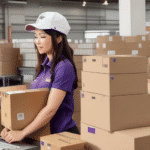Understanding USPS Shipping Zones
Shipping is a critical component for any business that sells products online. Timely and reliable delivery ensures customer satisfaction and protects your business’s reputation. The United States Postal Service (USPS) is one of the most popular and trusted shipping services in the United States, offering a variety of services tailored to businesses of all sizes.
What are USPS Shipping Zones and Why Do They Matter?
USPS uses "shipping zones" to determine the cost of sending a package from one location to another. Shipping zones are based on the distance between the origin and destination ZIP codes—the greater the distance, the higher the zone, leading to increased shipping costs. Understanding USPS shipping zones is essential for businesses to optimize their shipping expenses effectively.
It's important to note that USPS shipping zones are not the same as states or regions. For instance, two locations within the same state can belong to different zones based on their distance from each other. Additionally, USPS updates their zone charts annually, so staying informed about any changes is crucial for managing shipping costs. Regularly reviewing shipping zones can help businesses make informed decisions about their shipping strategies and potentially save money.
How USPS Shipping Zones are Determined
USPS divides the United States into nine shipping zones, with Zone 1 being the nearest and Zone 9 being the farthest. These zones are determined by the distance between the origin and destination ZIP codes, utilizing a mapping system that categorizes the zones accordingly.
However, distance is not the sole factor influencing shipping costs. The weight and size of the package also play significant roles. USPS has different pricing tiers based on the weight and size categories of the package. Furthermore, USPS offers various shipping options such as Priority Mail, First-Class Mail, and Media Mail, each with their own pricing structures and delivery timeframes.
Calculating Shipping Costs with USPS Zones
The Impact of Distance on USPS Shipping Costs
The distance between the origin and destination ZIP codes heavily influences USPS shipping costs. As the distance increases, the shipping zone number rises, resulting in higher shipping expenses. This is because USPS incurs greater operational costs, such as fuel, vehicle maintenance, and staffing, to deliver packages to distant locations.
Additionally, the weight and size of the package contribute to the overall shipping cost. Heavier and larger packages require more resources to transport and handle, which increases expenses. USPS also offers different shipping services like Priority Mail, First-Class Mail, and Express Mail, each with varying costs and delivery times.
Moreover, the type of item being shipped can affect costs. For example, hazardous materials, live animals, and perishable goods need special handling, leading to higher shipping prices. International shipments may also incur additional fees, including customs duties and taxes.
How to Calculate Shipping Costs Based on USPS Shipping Zones
To calculate shipping costs using USPS shipping zones, you need to know several factors:
- The weight and dimensions of your package
- Origin and destination ZIP codes
- The USPS shipping service you intend to use
With this information, you can use the USPS Postage Calculator to determine the cost based on the package’s weight and zone.
For example, shipping a package from New York to California will fall into a higher shipping zone than shipping within New York to New Jersey, resulting in higher costs. Selecting the appropriate USPS shipping service, such as Priority Mail for faster delivery or First-Class Mail for lighter packages, can also impact the total shipping cost.
Strategies to Optimize and Reduce USPS Shipping Costs
Tips for Reducing Shipping Costs When Dealing with USPS Zones
- Negotiate Volume Discounts: Businesses that ship large volumes can negotiate discounted rates with USPS, leading to significant cost savings.
- Use Flat-Rate Packaging: Utilizing USPS flat-rate boxes or envelopes can be more economical, especially for heavier packages, as the cost is determined by the box size rather than weight or distance.
- Leverage USPS Online Shipping Tools: Tools like Click-N-Ship or USPS Shipping Assistant allow businesses to print shipping labels and pay for postage online, saving time and reducing costs compared to visiting the post office.
- Utilize Regional Rate Boxes: USPS Regional Rate Boxes offer discounted rates for packages shipped within certain distances, making them a cost-effective option for frequent shipments to nearby locations.
Understanding the Different Types of USPS Shipping Services
- Priority Mail Express: Offers overnight to 2-day delivery with tracking and insurance.
- Priority Mail: Provides 1-3 day delivery with tracking.
- First-Class Mail: Best for lightweight packages, typically delivered within 1-3 days.
- USPS Retail Ground: Suitable for larger packages that do not require expedited delivery.
Choosing the Right USPS Shipping Service
Selecting the appropriate USPS shipping service depends on:
- Package Weight and Dimensions: Heavier and larger packages may benefit from flat-rate options.
- Delivery Timeline: Faster delivery options like Priority Mail Express are ideal for urgent shipments.
- Budget: Balancing cost with required delivery speed and service features.
- Tracking and Insurance Needs: For valuable or fragile items, opt for services that include detailed tracking and insurance.
Additionally, USPS offers optional services such as signature confirmation and delivery confirmation, providing added security and accountability for your shipments.
Common Pitfalls and Alternatives
Common Mistakes to Avoid When Dealing with USPS Shipping Zones
- Improperly Calculating Shipping Costs: Failing to accurately calculate shipping costs can result in overpaying. Always use reliable tools like the USPS Postage Calculator.
- Choosing the Wrong Shipping Service: Selecting a service that does not align with your delivery needs can lead to higher costs or slower delivery times.
- Ignoring Zone Updates: USPS shipping zones can change annually. Regularly check for updates to avoid unexpected cost increases.
- Poor Packaging and Labeling: Inadequately packaged or mislabeled shipments can cause delays or additional fees.
Alternatives to Using USPS for Your Shipping Needs
While USPS is a reliable shipping option, businesses may consider alternatives based on their specific needs:
- FedEx: Known for its fast and reliable delivery services, with a wide range of shipping options.
- UPS: Offers comprehensive shipping solutions, including international shipping and supply chain management services.
- DHL: Specializes in international shipping with extensive global coverage.
Choosing the right carrier depends on factors such as delivery speed, cost, package dimensions, and the geographic areas you serve. Comparing different carriers can help you select the most cost-effective and efficient option for your business.
Leveraging Technology for USPS Shipping Optimization
The Role of Shipping Software and Tools
Technology significantly aids businesses in navigating USPS shipping zones and optimizing shipping processes. Shipping software and tools allow businesses to efficiently calculate shipping costs, print labels, and manage shipments. For example, the USPS Shipping Assistant provides a streamlined interface for managing shipping tasks.
Additionally, integrating shipping software with e-commerce platforms can automate shipping calculations and reduce manual errors, saving time and resources.
Real-Time Tracking and Inventory Management
Real-time tracking software enables businesses to monitor the status of their shipments, providing accurate delivery estimates to customers. This improves customer satisfaction and helps businesses manage their inventory and plan future shipments more effectively.
Moreover, data analytics tools can help businesses analyze shipping patterns, identify inefficiencies, and optimize their shipping strategies for cost savings and improved delivery performance.
Future Trends in USPS Shipping Zones
The landscape of USPS shipping zones is evolving with advancements in technology and changing business needs. Automation and digitization are set to play a significant role in simplifying shipping processes, making it easier to navigate shipping zones and reduce costs.
Businesses can expect increased integration between shipping software and USPS services, providing more tools for cost optimization and enhanced tracking capabilities. Additionally, innovations in logistics and transportation technology may lead to more efficient delivery methods, potentially impacting shipping zones and costs.
Staying informed about these trends and leveraging new technologies will be essential for businesses aiming to maintain competitive shipping practices and meet customer expectations.
Conclusion
Understanding USPS shipping zones is essential for businesses aiming to optimize their shipping costs and ensure timely deliveries. By comprehending how shipping zones work, accurately calculating shipping costs, and utilizing strategies to reduce expenses, businesses can enhance their shipping efficiency. Leveraging technology further streamlines shipping processes, leading to significant time and cost savings. As the shipping industry continues to evolve, staying informed about changes in USPS shipping zones and adopting innovative solutions will help businesses maintain a competitive edge and achieve sustained growth.






















